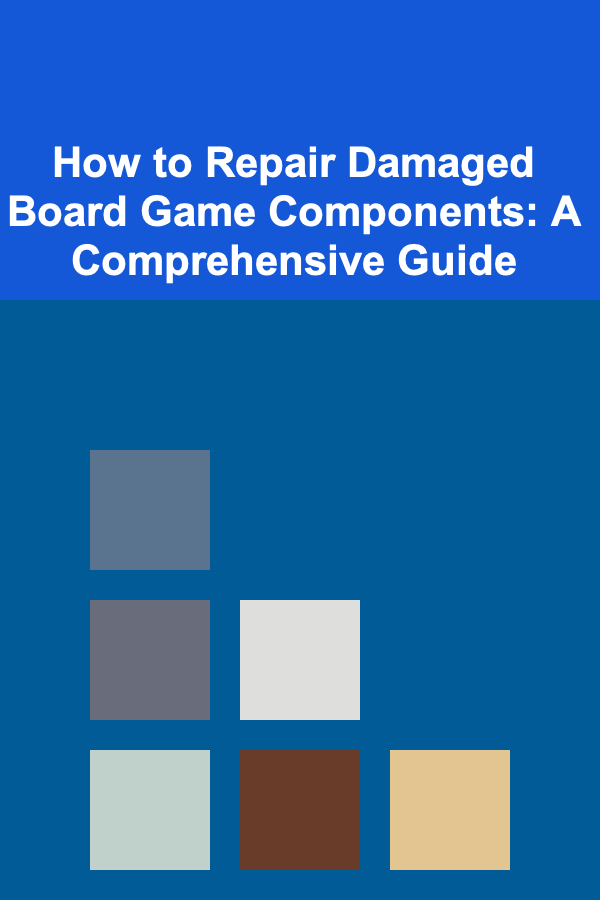
How to Repair Damaged Board Game Components: A Comprehensive Guide
ebook include PDF & Audio bundle (Micro Guide)
$12.99$7.99
Limited Time Offer! Order within the next:

Board games, cherished for their ability to bring people together and stimulate strategic thinking, are often treasured possessions. However, like any physical item, board game components are susceptible to damage from regular use, accidental spills, improper storage, or even just the passage of time. A ripped card, a broken miniature, or a warped game board can significantly detract from the enjoyment of a game. Fortunately, many common types of damage can be repaired at home with the right tools, techniques, and a bit of patience. This comprehensive guide will walk you through various repair methods, providing detailed instructions and helpful tips for restoring your beloved board games to their former glory.
Understanding the Damage: A Diagnostic Approach
Before diving into repairs, it's crucial to accurately assess the type and extent of the damage. This will dictate the best repair approach and the necessary materials. Consider the following questions:
- What type of component is damaged? (Cards, cardboard pieces, miniatures, dice, the game board, rulebook, etc.)
- What is the nature of the damage? (Tears, creases, bends, stains, breaks, warping, fading, etc.)
- How severe is the damage? (Minor surface scratch vs. a complete break)
- What material is the component made of? (Cardboard, paper, plastic, wood, etc.)
- Is the component essential for gameplay? (Can a missing piece be easily substituted or its function replicated?)
Answering these questions will help you formulate a repair plan that is both effective and appropriate for the specific situation. For example, a small crease on a card might only require gentle ironing, while a completely torn card may necessitate creating a replacement. Similarly, a minor chip on a plastic miniature might be easily repaired with glue, while a broken-off limb may require pinning and sculpting.
Essential Tools and Materials
Having the right tools and materials on hand will significantly simplify the repair process and improve the quality of your results. Here's a list of essential items to keep in your board game repair kit:
- Adhesives:
- White Glue (PVA): A versatile, water-based glue suitable for paper, cardboard, and wood. Dries clear and flexible.
- Super Glue (Cyanoacrylate): A fast-drying, strong adhesive for plastic, metal, and small repairs. Use sparingly and with caution.
- Epoxy: A two-part adhesive that creates a very strong, durable bond. Ideal for heavier-duty repairs and filling gaps.
- Glue Sticks: For quick and temporary fixes, or adhering paper to paper.
- Cutting Tools:
- Craft Knife (X-Acto Knife): For precise cutting and trimming of paper, cardboard, and plastic.
- Scissors: A general-purpose cutting tool for larger cuts.
- Cutting Mat: Protects your work surface from scratches and cuts.
- Clamping and Holding Tools:
- Clamps: For holding pieces together while glue dries. Various sizes and types are useful.
- Rubber Bands: Can be used to apply gentle pressure to glued surfaces.
- Clothes Pins: Useful for holding small pieces together.
- Finishing Tools:
- Sandpaper (various grits): For smoothing rough edges and removing excess glue.
- Paintbrushes: For applying glue and paint.
- Toothpicks and Cotton Swabs: For applying glue in small areas and cleaning up excess.
- Palette Knife or Spatula: For mixing and applying epoxy or filler.
- Cleaning Supplies:
- Isopropyl Alcohol: For cleaning surfaces and removing residue.
- Mild Soap and Water: For general cleaning.
- Soft Cloths and Paper Towels: For wiping and cleaning.
- Other Useful Supplies:
- Card Sleeves: To protect cards from further damage and wear.
- Clear Tape: For temporary repairs or reinforcing weak areas.
- Iron: For flattening warped cardboard and paper.
- Ironing Board or Heat-Resistant Surface: For ironing.
- Modeling Clay or Putty: For filling gaps and sculpting miniatures.
- Paints and Markers: To match colors and touch up repairs.
- Printer and Paper: For creating replacement components.
- Scanner: For creating digital copies of components for reproduction.
- Ruler and Pencil: For measuring and marking.
Tip: Organize your repair kit in a dedicated box or container to keep all your tools and materials readily accessible.
Repairing Common Types of Damage
Now, let's delve into specific repair techniques for various types of board game component damage.
1. Torn or Creased Cards
Cards are among the most frequently handled components in board games and are therefore prone to wear and tear. Tears and creases can make cards easily identifiable, compromising gameplay.
a. Minor Tears and Creases
Repairing Minor Tears:
- Clean the area: Gently wipe the torn area with a clean, dry cloth to remove any dust or debris.
- Apply adhesive: Using a toothpick or fine-tipped applicator, apply a very thin layer of white glue to the edges of the tear.
- Align the edges: Carefully align the edges of the tear and press them together.
- Clamp or weigh down: Place a small piece of parchment paper or wax paper over the repaired area and weigh it down with a book or other flat object. Alternatively, use small clamps to hold the edges together.
- Allow to dry: Let the glue dry completely according to the manufacturer's instructions (usually several hours).
- Remove excess glue: Once dry, carefully remove any excess glue with a sharp craft knife.
- Consider sleeving: Sleeve the repaired card to protect it from further damage and ensure it blends in with the other cards.
Repairing Minor Creases:
For minor creases, ironing can often restore the card's flatness.
- Prepare the card: Place the card between two sheets of parchment paper or wax paper.
- Iron the card: Set your iron to a low, dry setting (no steam). Gently iron the card, moving the iron in a smooth, circular motion.
- Check the crease: Check the crease periodically. Repeat the ironing process until the crease is minimized or eliminated.
- Weigh down the card: Place the card under a heavy book or flat object for several hours to prevent it from re-creasing.
b. Major Tears and Missing Pieces
Repairing major tears or replacing missing pieces requires more advanced techniques.
- Scan the card: If possible, scan the damaged card at a high resolution. This will allow you to create a digital copy for printing.
- Edit the scan: Use a photo editing program to repair any damage in the digital image. You may need to source images of similar cards or use your artistic skills to recreate missing details.
- Print the replacement: Print the repaired image onto card stock that is similar in weight and texture to the original card.
- Cut out the replacement: Carefully cut out the printed replacement card using a craft knife and ruler.
- Adhere to original: Glue the printed image onto the original damaged card, using white glue sparingly. Alternatively, glue the front and back printed images to a piece of neutral core board to recreate the card stock.
- Sleeve the card: Sleeve the repaired card to protect it and help it blend in with the other cards.
Warning: Exercise caution when using a craft knife. Always cut on a cutting mat and keep your fingers away from the blade.
2. Damaged Cardboard Components (Tiles, Boards, Chits)
Cardboard components, such as game boards, tiles, and chits, are susceptible to bending, warping, tears, and delamination (separation of the cardboard layers).
a. Bending and Warping
Flattening Warped Boards:
- Ironing (for minor warping): Similar to repairing creased cards, you can use an iron to flatten mildly warped cardboard. Place the board between two sheets of parchment paper or wax paper and iron on a low, dry setting. Apply gentle pressure and move the iron in a circular motion.
- Weighting (for moderate to severe warping): Place the warped board on a flat surface and cover it with a heavy object, such as a stack of books. Leave it for several days or even weeks. This method is slow but effective for gradually flattening the board.
- Humidity Control: Cardboard is susceptible to humidity. Storing games in a dry environment can help prevent warping. If the board is warped due to humidity, try placing it in a dry environment with weights for a few days.
b. Tears and Delamination
Repairing Tears:
- Apply adhesive: Apply a thin layer of white glue to the edges of the tear.
- Align the edges: Carefully align the edges of the tear and press them together.
- Clamp or weigh down: Place a piece of parchment paper or wax paper over the repaired area and weigh it down with a book or other flat object. Alternatively, use small clamps to hold the edges together.
- Allow to dry: Let the glue dry completely.
- Reinforce the back (optional): For added strength, you can reinforce the back of the tear with a piece of tape or a small patch of cardboard.
Repairing Delamination:
- Apply adhesive: Carefully apply a thin layer of white glue between the separated layers of cardboard.
- Press together: Press the layers together firmly.
- Clamp or weigh down: Place a piece of parchment paper or wax paper over the repaired area and weigh it down with a book or other flat object. Use clamps to hold the edges together if necessary.
- Allow to dry: Let the glue dry completely.
- Clean up excess glue: Remove any excess glue with a damp cloth.
c. Replacing Missing or Damaged Cardboard Pieces
- Scan the original: Scan a similar, undamaged piece or reconstruct the image digitally if the piece is completely missing. Note the thickness of the original cardboard.
- Print the replacement: Print the image onto adhesive paper.
- Adhere to cardboard: Obtain cardboard of the same thickness as the original. Adhere the printed image to the cardboard. You may need to adhere the printed image on both sides to prevent warping.
- Cut the piece: Cut the piece using a craft knife and ruler.
3. Broken Miniatures
Miniatures, often made of plastic or resin, are particularly vulnerable to breaking, especially during storage or handling.
a. Reattaching Broken Pieces
- Clean the broken surfaces: Clean the broken surfaces with isopropyl alcohol to remove any dirt, grease, or paint.
- Apply adhesive: Apply a small amount of super glue or epoxy to one of the broken surfaces.
- Align and attach: Carefully align the broken pieces and press them together firmly.
- Hold in place: Hold the pieces in place for several minutes until the glue begins to set. Use clamps or tape to secure the pieces if necessary.
- Allow to dry: Let the glue dry completely according to the manufacturer's instructions.
- Reinforce with pinning (optional): For added strength, you can reinforce the joint with a pin. Drill small holes into both pieces and insert a small piece of wire or a pin. Glue the pin in place.
- Fill gaps: If there are any gaps or imperfections, fill them with modeling clay or putty.
- Sand and smooth: Once the filler is dry, sand it smooth with fine-grit sandpaper.
- Paint: Paint the repaired area to match the original miniature.
b. Replacing Missing Pieces
Replacing missing pieces of miniatures can be challenging, but not impossible.
- Sculpt a replacement: Use modeling clay or putty to sculpt a replacement for the missing piece. Use reference images or other miniatures as a guide.
- Cure the clay/putty: Allow the clay or putty to cure according to the manufacturer's instructions.
- Sand and smooth: Sand the sculpted piece smooth with fine-grit sandpaper.
- Attach the replacement: Attach the sculpted piece to the miniature with super glue or epoxy.
- Paint: Paint the replacement piece to match the original miniature.
Note: For complex repairs or valuable miniatures, consider seeking the assistance of a professional miniature repair service.
4. Damaged Dice
Dice can become chipped, cracked, or faded over time. While minor cosmetic damage is usually acceptable, significant damage can affect the fairness and randomness of the dice.
a. Repairing Chips and Cracks
- Clean the damaged area: Clean the chipped or cracked area with isopropyl alcohol.
- Apply adhesive: Apply a small amount of super glue or epoxy to the damaged area.
- Fill the chip/crack: Use a toothpick or fine-tipped applicator to carefully fill the chip or crack with the adhesive.
- Allow to dry: Let the adhesive dry completely.
- Sand and smooth: Sand the repaired area smooth with fine-grit sandpaper.
- Polish (optional): Polish the repaired area with a polishing cloth or compound to restore the shine.
- Repaint numbers (if necessary): If the numbers on the dice have been damaged, repaint them with acrylic paint.
b. Replacing Damaged Dice
If the damage is severe or affects the balance of the dice, it is best to replace them. Many board game manufacturers sell replacement dice, or you can find suitable replacements at hobby stores or online retailers.
5. Damaged Rulebooks
Rulebooks are essential for playing board games, and damage to the rulebook can make it difficult to learn or remember the rules.
a. Torn Pages
- Apply adhesive: Apply a thin layer of white glue to the edges of the tear.
- Align the edges: Carefully align the edges of the tear and press them together.
- Clamp or weigh down: Place a piece of parchment paper or wax paper over the repaired area and weigh it down with a book or other flat object.
- Allow to dry: Let the glue dry completely.
- Reinforce the back (optional): For added strength, you can reinforce the back of the tear with a piece of tape.
b. Loose Binding
- Apply adhesive: Apply a thin layer of white glue to the spine of the rulebook.
- Clamp: Clamp the rulebook tightly together.
- Allow to dry: Let the glue dry completely.
c. Creating Replacement Pages
- Scan the page: Scan the damaged page at a high resolution.
- Edit the scan: Use a photo editing program to repair any damage in the digital image.
- Print the replacement: Print the repaired image onto paper that is similar in weight and texture to the original pages.
- Cut out the replacement: Carefully cut out the printed replacement page.
- Insert the replacement: Insert the replacement page into the rulebook, securing it with glue or tape.
Preventative Measures: Protecting Your Investment
Prevention is always better than cure. Taking proactive steps to protect your board game components can significantly reduce the risk of damage.
- Proper Storage: Store your board games in a cool, dry place, away from direct sunlight and extreme temperatures. Avoid storing games in humid environments, as this can cause warping and mold growth.
- Card Sleeves: Use card sleeves to protect your cards from scratches, dirt, and wear.
- Component Organizers: Use component organizers to keep your game pieces neatly separated and protected.
- Careful Handling: Handle your game components with care. Avoid bending or folding cards, and be gentle when handling miniatures.
- Protective Mats: Use a game mat or play surface to protect your game board from scratches and spills.
- Clear Rules Explanations: Ensure all players understand how to properly handle and use the game components.
- Avoid Food and Drinks: Keep food and drinks away from the game playing area to prevent spills and stains.
- Regular Cleaning: Clean your game components regularly with a soft, dry cloth to remove dust and debris.
Conclusion
Repairing damaged board game components can be a rewarding experience, allowing you to preserve your cherished games for years to come. By understanding the types of damage, utilizing the right tools and techniques, and taking preventative measures, you can keep your board games in excellent condition and continue to enjoy them with friends and family. Remember to approach repairs with patience and care, and don't be afraid to experiment and adapt the techniques described in this guide to suit your specific needs. Happy gaming!

How to Create a Home Decor Wishlist on a Budget
Read MoreHow to Create Custom Dashboards for Campaign Tracking
Read More
How to Diversify Your Investment Portfolio for Stability
Read More
How to Make a Portable Emergency Kit for Travel
Read More
How to Soundproof Your Walls Using Cheap and Easy Methods
Read More
How To Make Your Own Personal Care Products
Read MoreOther Products

How to Create a Home Decor Wishlist on a Budget
Read MoreHow to Create Custom Dashboards for Campaign Tracking
Read More
How to Diversify Your Investment Portfolio for Stability
Read More
How to Make a Portable Emergency Kit for Travel
Read More
How to Soundproof Your Walls Using Cheap and Easy Methods
Read More